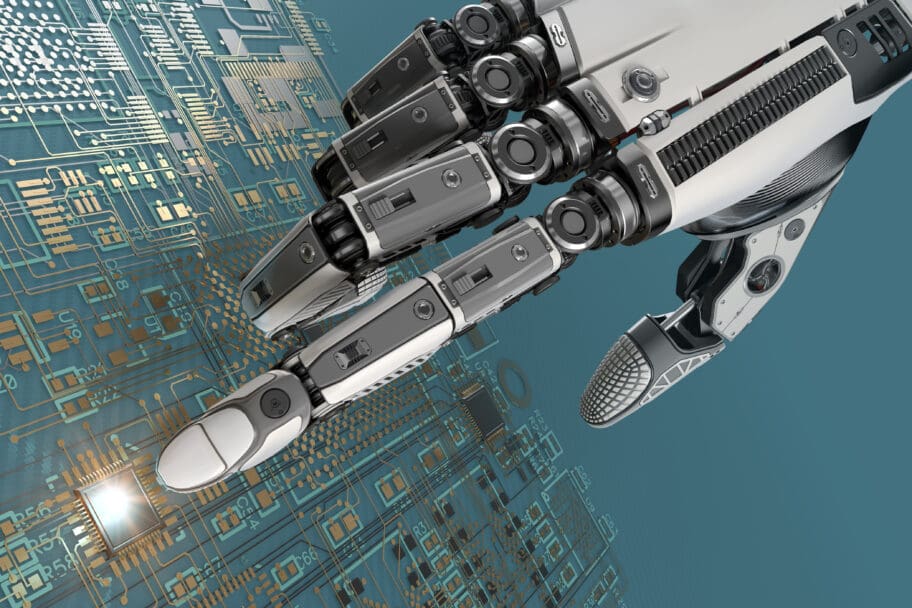In the fast-paced world of business, every organization is constantly seeking ways to enhance enterprise workflows and cut costs. This is where AI-driven automations come into play. By incorporating artificial intelligence into your marketing workflows, you can streamline repetitive tasks, reduce human error, and significantly improve overall efficiency. The use of software robots further aids in boosting productivity in your workflow processes.
AI workflow automation and conversational RPA offer a range of benefits that can revolutionize the way your enterprise workflows operate. From automating data entry and document processing with software robots to managing customer inquiries and analyzing data, AI can handle a multitude of tasks with speed and accuracy. This means your employees can focus on more strategic and creative endeavors, ultimately driving innovation, growth, and effective automations.

Not only does AI workflow automation save valuable time and effort, but it also helps to reduce costs. By simplifying and expediting business processes with automations and software robots, you can eliminate unnecessary expenses associated with manual labor and inefficient workflows. This is where the power of conversational RPA comes in to automate tasks, enhancing efficiency further.
In today's competitive landscape, embracing AI to automate tasks and enterprise workflows is no longer an option, but a necessity. Unlock the full potential of your marketing workflows and conversational rpa, boost productivity, and cut costs by harnessing the power of AI.
The Importance of Productivity and Cost-Cutting in Business
Productivity and cost-cutting are two crucial factors that determine the success of any business. In today's competitive landscape, organizations are constantly looking for ways to optimize their workflows, reduce expenses, and increase efficiency in various tasks. AI and conversational RPA provide a powerful solution to automate these manual tasks and achieve these goals.
By implementing a workflow automation strategy, businesses can streamline repetitive and time-consuming tasks, thereby freeing up valuable resources for more crucial activities. Workflow orchestration, for example, can replace hours spent manually entering data into spreadsheets with AI doing it in a fraction of the time. This allows employees to focus on higher-value tasks within their workflows that require critical thinking and creativity, such as marketing strategies.
Furthermore, cost-cutting is a key priority for businesses of all sizes, especially in areas of sales and service. Manual processes not only consume valuable time but also incur additional costs. By implementing AI workflow automation, organizations can eliminate unnecessary expenses associated with manual labor and inefficient workflows. This includes reducing the need for additional staff, minimizing human errors in sales and service operations, and optimizing resource allocation.
Understanding How AI Workflow Automation Works
AI workflow automation, a product of AI service, utilizes artificial intelligence algorithms and machine learning capabilities to automate repetitive tasks and streamline workflows in business processes. By analyzing patterns and data, AI can make intelligent decisions and perform tasks that were traditionally done by humans in service industries.
The first step in implementing AI workflow automation is to identify the tasks and service processes that can be automated. This can include workflows such as data entry, document processing, customer support, inventory management, and many other repetitive tasks that consume valuable time and resources.
Once the tasks are identified in the workflow automation strategy, AI algorithms are trained using historical data to recognize patterns and make accurate predictions. This training process ensures that the AI system can understand and perform the workflows effectively, contributing to efficient workflow orchestration. Advanced machine learning techniques enable the AI system to continuously learn and improve its performance over time, enhancing the product.
Benefits of AI Workflow Automation
The benefits of AI workflow automation are numerous and impactful. Here are some key advantages that businesses can gain by embracing AI workflows in their product or service management.
1. Improved productivity and efficiency
By automating repetitive tasks, AI workflow automation significantly improves productivity and efficiency in sales and service orchestration. The time saved from manual labor can be utilized for more strategic and creative workflows, driving innovation and growth within the organization. Employees can focus on tasks that require critical thinking, decision-making, and problem-solving in service orchestration, leading to higher-quality outputs.
2. Reduced human error
Humans are prone to errors, especially when performing repetitive service tasks for extended periods. AI workflow orchestration eliminates human error by ensuring consistent and accurate execution of tasks. With workflows automation tools, this leads to improved data quality, reduced rework, and enhanced customer satisfaction.
3. Cost savings
One of the most significant benefits of AI workflow automation in sales and service workflows is the cost savings it offers. By eliminating manual labor and streamlining processes via platforms like Octavius, businesses can reduce operational costs associated with hiring additional staff, training, and managing resources. Additionally, AI systems can work around the clock, reducing the need for overtime pay and increasing overall efficiency within sales workflows.
4. Enhanced customer experience
AI workflow automation can greatly enhance the sales experience by providing faster response times, personalized interactions, and accurate content information. For example, AI-powered chatbots can handle customer inquiries, provide instant support, and even make recommendations based on customer preferences. This not only improves customer satisfaction but also frees up human agents to focus on more complex customer issues.
5. Data-driven insights and decision-making
AI workflow automation enables businesses to gather and analyze vast amounts of data in real-time. This data can be used to identify sales trends, make informed service decisions, and drive strategic initiatives. By leveraging AI-powered analytics tools, businesses can gain valuable insights into customer behavior, market trends, and operational performance, leading to more informed decision-making.
Case Studies of Successful AI Workflow Automation Implementations
In the dynamic landscape of modern business, the convergence of AI and automation is paving the way for unparalleled efficiency and innovation. This powerful fusion, known as AI automation workflow, has transcended industries and functions, reshaping operations and accelerating growth. Let's explore five remarkable case studies from AIMultiple’s report (https://research.aimultiple.com) that showcase the transformative impact of AI automation workflow across the globe.

Aon Italy
In the heart of Italy, Aon Italy harnessed the prowess of IBM's AI automation workflow to lighten the load for its 1,600 employees. The result? Streamlined workloads, optimized processes, and a significant boost in overall operational efficiency.
Cobmax Sales Center
IBM's AI automation workflow redefined efficiency at Cobmax Sales Center in Brazil. With reduced completion times for client reports – from 2-3 days to just 1 – Cobmax experienced a remarkable acceleration in its operations, translating into enhanced customer experiences.
Credigy Solutions Inc.
In the United States, Credigy Solutions Inc. partnered with IBM's AI automation workflow to revolutionize financial services. The outcome? A staggering 100% automated due diligence reviews of loan-related documents, contributing to a growth rate exceeding 15% compounded annually.
Deloitte
Globally renowned Deloitte leveraged IBM's AI automation workflow to redefine its professional services landscape. The impact? Reduced management report preparation time from 5-8 days to a mere hour and travel expense report preparation time from 3 hours a day to just 10 minutes.
GAM Distributors of Medicines and Perfumery
In Brazil, IBM's AI automation workflow transformed operations for GAM Distributors of Medicines and Perfumery. By automating 22 processes within a year, they achieved substantial cost savings of around BRL 120,000 annually.
Charting the Future with AI Automation Workflow
As you delve into the realm of AI automation workflow, consider these inspiring success stories as beacons of innovation. They illuminate the path towards transforming operations and driving growth, offering actionable insights that transcend theoretical concepts.
Embracing AI Automation Workflow
To embark on your journey of AI automation workflow integration, explore the comprehensive capabilities of AI automation tools and vendor comparisons. Dive deeper into specific domains like Natural Language Processing (NLP) and computer vision to tailor solutions that align with your business needs.
Best Practices for Implementing AI Workflow Automation
Implementing AI workflow automation and orchestration requires careful planning and execution. Here are some best practices to consider, including the use of tools like Zapier.
1. Identify the right tasks and processes
Start by identifying the tasks and processes that can be automated effectively with orchestration. Focus on repetitive tasks that consume significant time and resources, and have a high potential for error. Incorporating tools will ensure that your AI workflow automation efforts deliver maximum impact.
2. Choose the right AI tools and software
There are numerous AI tools and software available in the market, including workflow automation strategy solutions and workflow orchestration systems. Take the time to research and choose the ones that align with your business needs and goals. Look for solutions that offer scalability, flexibility, and integration capabilities to ensure a seamless implementation of your chosen workflow automation strategy.
3. Train and upskill employees
Implementing AI workflow automation and orchestration requires a shift in mindset and skill set. It is crucial to train and upskill employees to work alongside AI systems and tools effectively. Provide training programs that focus on developing skills such as data analysis, critical thinking, and problem-solving. This will empower employees to leverage AI technology, orchestration, and Zapier, contributing to the organization's success.
4. Monitor and evaluate performance
Regularly monitor and evaluate the performance of your AI workflow automation systems, focusing on orchestration and tools. Analyze key metrics such as productivity, cost savings, customer satisfaction, and data accuracy. This will help you identify areas for improvement and make necessary adjustments to optimize the efficiency of your AI systems.
Overcoming Common Challenges in AI Workflow Automation
While AI workflow automation and orchestration offer numerous benefits, there are also some challenges that organizations may face during implementation with tools. Here are a few common challenges and strategies to overcome them.
1. Resistance to change
Resistance to change is a common challenge when implementing AI workflow automation. Employees may feel threatened by the idea of automation replacing their roles. To overcome this challenge, it is essential to provide clear communication and transparency throughout the implementation process. Involve employees in the decision-making process and highlight the benefits that AI workflow automation brings to their roles, like freeing up time for more meaningful work.
2. Data quality and privacy concerns
AI systems rely heavily on data to make accurate decisions. Ensuring data quality and privacy is crucial to the success of AI workflow automation, a feature most tools excel in. Implement robust data governance practices, including data cleansing, data validation, and secure storage. Communicate the importance of data privacy to employees and customers, and ensure compliance with relevant regulations such as GDPR.
3. Integration with existing systems
Integrating AI workflow automation with existing systems can be challenging, especially if the systems are outdated or fragmented. Prioritize integration with systems during the planning phase and ensure compatibility between AI tools and existing infrastructure. Consider partnering with experienced AI vendors who can provide guidance and support throughout the integration process.
Choosing the Right AI Workflow Automation Tools and Software
Choosing the right AI workflow automation tools and software is crucial for a successful implementation. Here are some factors to consider when selecting AI tools.
1. Scalability and flexibility
Choose AI tools that can scale with your business and adapt to changing needs. Look for solutions that offer flexibility in terms of customization, integration, and upgrades. This will ensure that your AI workflow automation systems can grow and evolve alongside your organization.
2. Ease of use and user interface
User experience is crucial when implementing AI workflow automation. Choose systems with an intuitive user interface that is easy to navigate and understand. This will minimize the learning curve for employees and encourage adoption of the AI systems.
3. Vendor reputation and customer support
Research the reputation of AI vendors, particularly those specializing in workflow orchestration and tools. Assess their track record in delivering successful implementations. Read customer reviews, case studies, and testimonials to gain insights into the vendor's capabilities in these areas and their customer support. Choose vendors who have a proven track record in workflow orchestration and offer reliable support services for tools.
Training and Upskilling Employees for AI Workflow Automation
Training and upskilling employees is essential for successful AI workflow automation implementation. Here are some strategies to consider.
1. Develop a comprehensive training program
Design a comprehensive training program that covers the basics of AI, its applications, and the specific AI tools, software, and workflow orchestration that will be implemented. Provide hands-on training sessions to familiarize employees with the AI systems, workflow orchestration processes, and encourage experimentation and learning.
2. Foster a culture of continuous learning
Encourage a culture of continuous learning and improvement within your organization. Provide opportunities for employees to attend workshops, webinars, and conferences to stay updated with the latest advancements in AI workflow automation. This will ensure that employees are equipped with the knowledge and skills necessary to work alongside AI systems effectively.
3. Empower employees to contribute
Empower employees to actively contribute to the AI workflow automation implementation process. Encourage them to share their ideas, feedback, and suggestions for improvement. This will foster a sense of ownership and engagement, leading to a more successful implementation.
Future Trends and Advancements in AI Workflow Automation
The field of AI workflow automation is rapidly evolving, and there are several exciting trends and advancements on the horizon.

Here are a few that are worth keeping an eye on:
1. Natural language processing (NLP)
Natural language processing is a branch of AI that focuses on enabling machines to understand and respond to human language. Advancements in NLP and workflow orchestration will enable more sophisticated and context-aware AI-powered chatbots and virtual assistants, leading to enhanced customer interactions and personalized experiences.
2. Robotic Process Automation (RPA)
Robotic Process Automation is a technology that allows organizations to automate repetitive tasks by creating software robots or "bots." RPA combined with AI workflow automation can further streamline business processes, improve accuracy, and reduce costs.
3. Predictive analytics and machine learning
Predictive analytics and machine learning algorithms are becoming increasingly sophisticated, enabling businesses to make accurate predictions and proactive decisions. The integration of these technologies with AI workflow automation will enable organizations to optimize their operations, identify potential risks, and make data-driven decisions with ease.
Conclusion
In today's competitive landscape, embracing AI workflow automation is no longer an option, but a necessity. By incorporating artificial intelligence into your workflow processes, you can boost productivity, cut costs, and unlock the full potential of your organization. AI workflow automation offers a range of benefits, including improved efficiency, reduced human error, cost savings, enhanced customer experiences, and data-driven insights. By following best practices, overcoming common challenges, and choosing the right tools and software, you can successfully implement AI workflow automation and stay ahead of the curve. Embrace the power of AI and revolutionize the way your business operates.
FAQs
How AI can be used in workflow automation?
AI improves workflow automation in many ways. What’s important here is that AI can not only automate tasks included in the workflow but also be the tool dedicated to optimizing the workflow in general. This means that artificial intelligence systems are perfect for the majority of business processes.
How are companies using it to reach KPIs?
Companies that are deploying Workflow Automation Solutions are primarily first focusing on the Conversational aspects of it. They fine-tune the message delivered to the end users based on the context of the engagement, clearly establish the purpose of the engagement with the user, are very specific in what they expect from the customer, they set reminders to the end users accommodating the users behavioral patterns and finally they convey to the end user if the purpose of the engagement is achieved.
How do I choose the right AI workflow automation software?
Choosing the right AI-driven workflow automation software will depend on which department you’re trying to automate, but the basic steps are the same for everyone.
What features matter for AI workflow automation?
The features that matter for AI workflow automation depend on the goals your team is trying to achieve.

Article by
Titus Mulquiney
Hi, I'm Titus, an AI fanatic, automation expert, application designer and founder of Octavius AI. My mission is to help people like you automate your business to save costs and supercharge business growth!
